The single phase spot welder market is valued at USD 281.4 million in 2025 and forecasted to reach USD 518.5 million by 2035, advancing at a CAGR of 6.3%. A market share erosion or gain analysis highlights how value distribution is expected to shift across stakeholders over the forecast horizon. From 2020 to 2025, revenue climbs from USD 207.4 million to USD 281.4 million, with steady adoption in automotive repair, light fabrication, and consumer goods manufacturing. During this stage, established players maintain strong market share as their brand reputation, distribution networks, and after-sales service support customer loyalty, preventing significant erosion.
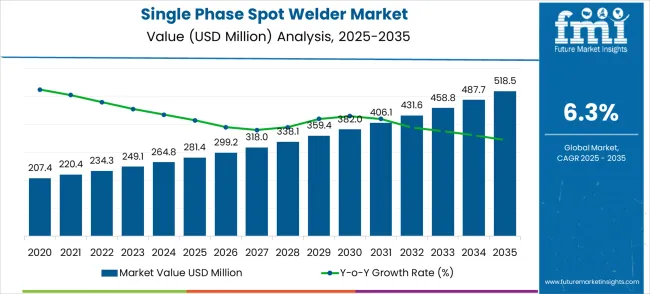
| Metric | Value |
|---|---|
| Market Value (2025) | USD 281.4 million |
| Market Forecast Value (2035) | USD 518.5 million |
| Forecast CAGR (2025-2035) | 6.3% |
Between 2025 and 2030, the market expands from USD 281.4 million to USD 382.0 million, adding USD 100.6 million in absolute terms. This period sees a gradual reshaping of market share as new entrants and regional manufacturers introduce competitively priced models targeting small workshops and mid-sized fabrication businesses. Gains are likely to shift toward companies offering energy-efficient, portable, and multi-functional welders, while traditional players may experience share erosion if they fail to innovate beyond incremental upgrades. Mid-decade adoption reflects stronger competitive dynamics, where service differentiation and pricing strategies drive notable share redistribution.
From 2030 to 2035, revenue grows further from USD 382.0 million to USD 518.5 million, representing an absolute gain of USD 136.5 million. Market share gains are expected for suppliers that integrate digital controls, monitoring features, and value-added service packages, strengthening their appeal in high-volume operations. Conversely, erosion is anticipated among manufacturers relying solely on conventional designs, as replacement cycles favor advanced models. Geographic penetration in emerging economies creates additional opportunities for share gains among regional players. By 2035, the market demonstrates a competitive balance where innovators capture incremental growth, while lagging participants see reduced market presence, solidifying the redistribution of market share across the decade.
Market expansion is being supported by revolutionary advances in welding automation technology and manufacturing efficiency solutions, creating unprecedented opportunities for precision joining and comprehensive production optimization. Modern manufacturing applications increasingly demand sophisticated spot welding systems that deliver consistent weld quality, enable high-speed production cycles, and provide reliable joining capabilities for automotive assembly and precision manufacturing processes. The integration of advanced control technology with comprehensive welding automation enables previously impossible levels of production precision and manufacturing efficiency optimization.
The growing focus on automotive manufacturing and production automation is driving massive demand for single phase spot welders from leading manufacturing companies with proven track records of innovation and welding expertise. Automotive manufacturers and industrial fabrication firms are investing significantly in spot welding technologies that offer superior joining quality while providing enhanced production throughput and comprehensive manufacturing integration through advanced welding automation protocols. Manufacturing standards are establishing performance benchmarks that favor automated spot welding systems with advanced control capabilities and superior production efficiency features.
The manufacturing industry's transformation toward automated production systems is creating substantial demand for intelligent spot welding products capable of delivering professional-grade joining and manufacturing integration through advanced welding automation platforms. The automotive sector continues to drive innovation in welding automation applications while maintaining quality reliability and production efficiency, leading to development of breakthrough spot welding systems with enhanced precision capabilities and comprehensive manufacturing integration.
The market is segmented by power type, application, and region. By power type, the market is divided into DC and AC configurations. Based on application, the market is categorized into automotive maintenance and manufacturing, aerospace & precision manufacturing, appliance & light manufacturing, and other applications. Regionally, the market is divided into North America, Europe, East Asia, South Asia & Pacific, Latin America, and Middle East & Africa.
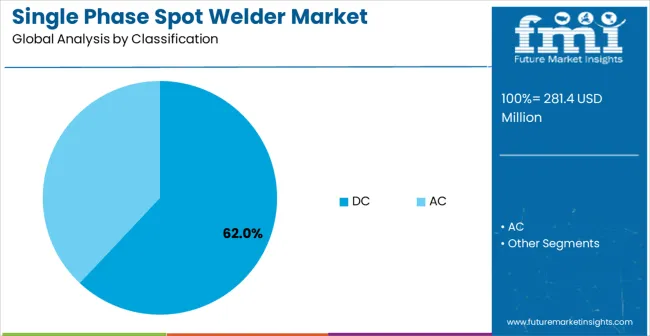
DC power type configurations are projected to account for 62% of the single phase spot welder market in 2025. This leading share is supported by explosive adoption of precise welding control requirements and growing demand for consistent weld quality through advanced power regulation technology. DC spot welders provide unprecedented welding precision and power control capabilities, making them the preferred choice for automotive manufacturers seeking comprehensive joining solutions and enhanced production quality. The segment benefits from revolutionary advances in power electronics technology, welding control systems, and energy efficiency solutions that have created entirely new categories of high-precision welding devices.
Modern DC spot welders incorporate sophisticated power control algorithms and advanced welding management systems that enable real-time weld parameter adjustment, consistent energy delivery, and seamless integration with automated production lines while ensuring superior weld quality and comprehensive manufacturing integration. These innovations have transformed automotive manufacturing while providing superior joining capabilities for precision assembly and production optimization through continuous welding control and intelligent power management. The automotive manufacturing market particularly drives demand for DC spot welding solutions, as these applications require precise power control and reliable welding quality to deliver superior production outcomes and manufacturing efficiency optimization.
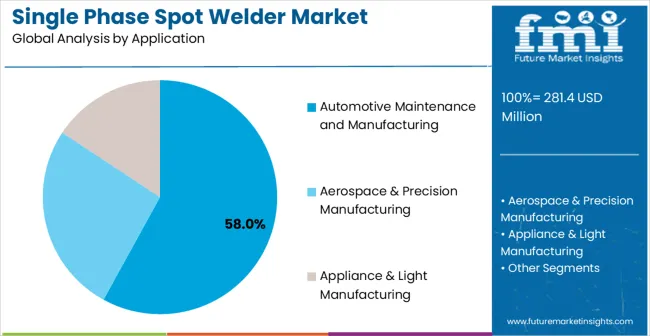
Automotive maintenance and manufacturing applications are expected to represent 58% of single phase spot welder demand in 2025. This dominant share reflects the massive automotive industry market for production welding and growing investment in automated manufacturing technologies for comprehensive automotive assembly. Automotive applications enable comprehensive production welding through sophisticated spot joining, automated assembly lines, and advanced quality control systems. The segment benefits from breakthrough advances in automotive manufacturing technology that makes sophisticated welding automation accessible and critical for production efficiency and assembly quality optimization.
The global automotive revolution drives significant demand for automotive spot welding systems that provide exceptional joining capabilities and intelligent production integration for automotive assembly and manufacturing quality applications. These applications require spot welding systems with superior welding abilities and comprehensive automotive integration to ensure reliable production joining and effective manufacturing quality capabilities. The segment benefits from growing automotive investment in production automation technologies and increasing implementation of advanced manufacturing systems and comprehensive assembly solutions.
Automotive and manufacturing sectors contribute substantially to market growth as companies implement spot welding systems in production lines and comprehensive manufacturing automation strategies. The growing adoption of automated production creates opportunities for specialized automotive spot welding systems designed for assembly line applications and comprehensive manufacturing quality management.
The single phase spot welder market is advancing steadily due to revolutionary welding automation development and unprecedented adoption of manufacturing efficiency technologies across all automotive and industrial manufacturing segments. However, the market faces challenges including equipment investment costs, need for robust welding quality validation, and varying production requirements across different manufacturing applications. Welding standards and manufacturing regulations continue to influence product development and market adoption patterns.
The revolutionary advances in welding control systems, power regulation algorithms, and automated production technologies are enabling unprecedented manufacturing joining capabilities while maintaining welding quality and production efficiency standards. Advanced welding architectures and manufacturing-specific control systems provide superior joining quality and production control capabilities, enabling dynamic manufacturing optimization and enhanced welding accuracy. These technologies are particularly valuable for automotive applications that require sophisticated welding control, accurate joining processes, and reliable manufacturing standardization protocols.
Modern single phase spot welder manufacturers are implementing breakthrough ecosystem integration and comprehensive manufacturing platform development that enables seamless production integration while supporting holistic manufacturing optimization and quality management enhancement. Advanced platform architectures enable unified welding control, production monitoring, and quality management while ensuring manufacturing reliability and production operational requirements.
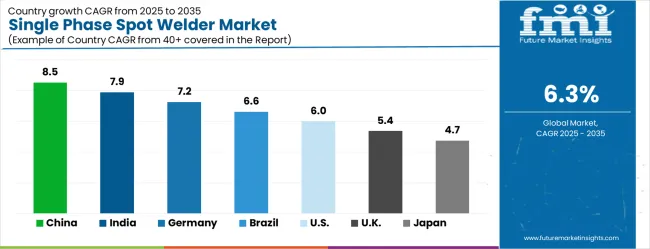
| Country | CAGR (2025-2035) |
|---|---|
| China | 8.5% |
| India | 7.9% |
| Germany | 7.2% |
| Brazil | 6.6% |
| United States | 6.0% |
| United Kingdom | 5.4% |
| Japan | 4.7% |
The single phase spot welder market is experiencing solid growth, with China leading at 8.5% CAGR through 2035, driven by massive automotive manufacturing expansion and rapidly growing industrial production infrastructure. India follows at 7.9%, supported by enormous manufacturing development potential and increasing automotive assembly investment. Germany records strong growth at 7.2%, emphasizing manufacturing technology innovation excellence and advanced welding system development. Brazil grows steadily at 6.6%, benefiting from expanding automotive manufacturing and industrial production development. The United States shows consistent growth at 6.0%, focusing on manufacturing technology advancement and precision welding applications. The United Kingdom maintains steady expansion at 5.4%, supported by manufacturing innovation development. Japan demonstrates stable growth at 4.7%, emphasizing precision welding technology and manufacturing excellence.
The report covers an in-depth analysis of 40+ countries top-performing countries are highlighted below.
Revenue from single phase spot welders in China is projected to exhibit the highest growth rate with a CAGR of 8.5% through 2035, driven by the country's position as a global automotive manufacturing powerhouse and massive domestic investment in industrial production infrastructure. The extensive automotive assembly capabilities and unprecedented investment in manufacturing automation technology are creating extraordinary opportunities for spot welding system adoption. Major automotive and manufacturing companies are developing world-leading welding capabilities to serve both the enormous domestic automotive market and global manufacturing expansion while establishing leadership in production welding applications.
Revenue from single phase spot welders in India is expanding at a CAGR of 7.9%, supported by the country's massive manufacturing development potential and rapidly accelerating automotive assembly across all industrial segments and production operations. The enormous automotive manufacturing growth and increasing industrial production investment are driving extraordinary spot welding system demand potential. Manufacturing technology companies are leveraging India's vast automotive market while developing cost-effective welding solutions to capture emerging opportunities in automotive assembly and industrial production applications.
Demand for single phase spot welders in Germany is projected to grow at a CAGR of 7.2%, supported by the country's leadership in manufacturing technology innovation and advanced welding system development across automotive, engineering, and industrial sectors. German welding technology companies are implementing sophisticated spot welding development that meets stringent quality standards and production requirements while delivering superior welding properties and system reliability. The market is characterized by focus on manufacturing innovation, advanced technology integration, and compliance with comprehensive welding quality and production efficiency regulations.
Revenue from single phase spot welders in Brazil is growing at a CAGR of 6.6%, driven by expanding automotive manufacturing and increasing industrial production investment across urban and emerging manufacturing market segments. The growing automotive awareness and increasing manufacturing infrastructure development are creating substantial opportunities for spot welding market development. Manufacturing technology companies are adapting spot welding systems to support growing automotive demand and industrial production while maintaining cost accessibility and local market relevance.
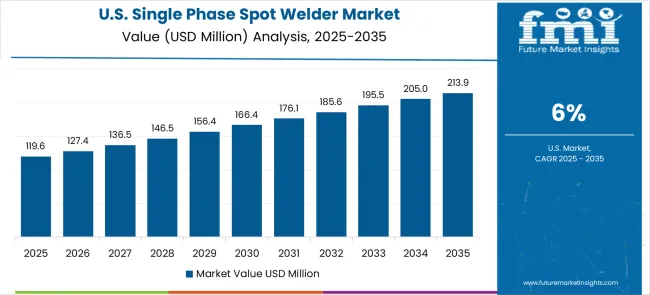
Demand for single phase spot welders in the United States is expanding at a CAGR of 6.0%, driven by the country's manufacturing technology advancement and automotive market demand for advanced welding products and cutting-edge production technologies. The sophisticated manufacturing infrastructure and automotive willingness to invest in advanced spot welding systems create significant demand for high-performance manufacturing solutions. The market benefits from breakthrough welding technology research and manufacturing-grade technology market segments across automotive, aerospace, and industrial applications.
Demand for single phase spot welders in the United Kingdom is projected to grow at a CAGR of 5.4%, supported by ongoing manufacturing innovation advancement and increasing automotive demand for intelligent welding products in automotive and industrial manufacturing applications. Welding technology companies are investing in manufacturing technology development that provides advanced functionality while meeting quality requirements and regulatory compliance for automotive applications. The market is characterized by focus on manufacturing innovation, welding quality protection, and advanced technology integration across diverse automotive manufacturing segments.
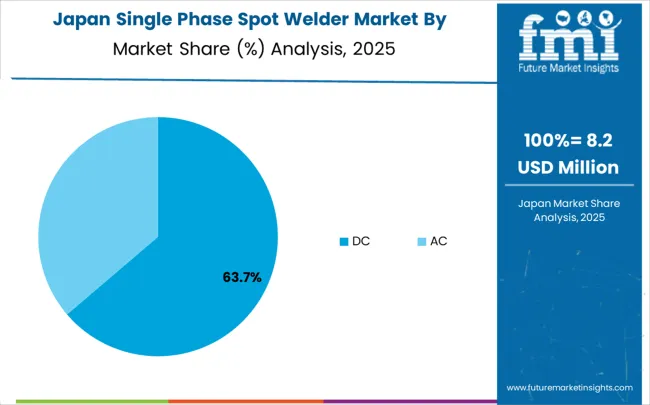
Demand for single phase spot welders in Japan is expanding at a CAGR of 4.7%, driven by the country's emphasis on welding technology excellence and precision manufacturing development across automotive, electronics, and industrial sectors. Japanese welding technology companies are developing sophisticated spot welding applications that incorporate precision engineering and manufacturing optimization principles. The market benefits from focus on welding precision, technology reliability, and continuous innovation in manufacturing technology and automotive assembly integration.
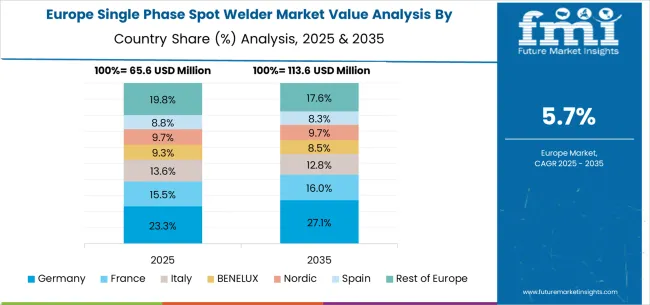
The single phase spot welder market in Europe is projected to grow from USD 75.3 million in 2025 to USD 138.8 million by 2035, registering a CAGR of 6.3% over the forecast period. Germany is expected to maintain its leadership with a 36.1% share in 2025, supported by its advanced automotive manufacturing industry and welding technology excellence. The United Kingdom follows with 22.4% market share, driven by manufacturing innovation advancement and welding technology development. France holds 18.3% of the European market, benefiting from automotive technology expansion and welding equipment industry development. Italy and Spain collectively represent 14.7% of regional demand, with growing focus on automotive manufacturing development and welding technology applications. The Rest of Europe region accounts for 8.5% of the market, supported by welding technology development in Eastern European countries and Nordic manufacturing innovation advancement.
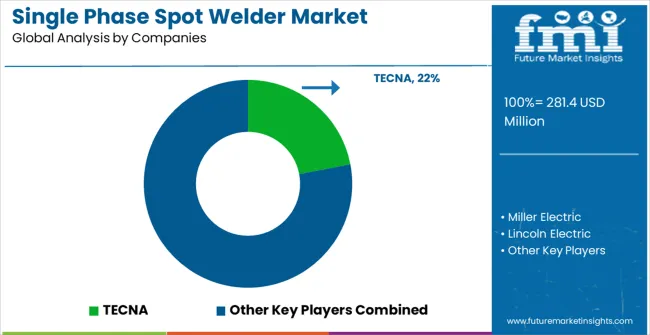
The single phase spot welder market is defined by moderate competition among welding equipment manufacturers, innovative manufacturing automation companies, and established automotive production suppliers. Companies are investing in welding technology development, advanced equipment design, welding quality validation, and manufacturing ecosystem integration to deliver reliable, efficient, and manufacturing-compatible spot welding products. Strategic partnerships, technological advancement, and steady automotive market expansion are central to achieving market leadership and manufacturing adoption.
TECNA, operating globally, offers comprehensive welding solutions with focus on automotive and industrial applications, welding performance optimization, and seamless manufacturing integration across welding equipment, control systems, and manufacturing services applications. Miller Electric, technology provider, delivers advanced welding systems with emphasis on manufacturing reliability, welding performance, and intelligent production integration capabilities. Lincoln Electric provides innovative welding solutions with focus on comprehensive manufacturing integration and high-performance welding applications. DAIDEN offers precision welding systems with advanced spot welding technology and manufacturing-grade performance capabilities.
Dahching Electric provides specialized welding systems with emphasis on automotive and industrial applications. Nippon Avionics delivers advanced welding technology with sophisticated manufacturing performance and production optimization capabilities. Sciaky offers comprehensive welding solutions with manufacturing integration and automotive welding services. Dengensha provides welding systems with advanced manufacturing integration and automotive welding systems.
AMADA WELD TECH, ARO Welding Technologies, Heron Intelligent Equipment, A.T.S. Lamberti, Obara Corporation, Fronius, Panasonic Welding Systems, and PEI offer specialized welding expertise, innovative product development, and technical advancement across spot welding and manufacturing technology networks.
The single phase spot welder market underpins automotive manufacturing revolution, production efficiency advancement, welding technology democratization, and manufacturing optimization evolution. With accelerating automotive production, manufacturing automation expansion, and welding quality requirements, the sector faces pressure to balance innovation velocity, production quality protection, and welding performance validation. Coordinated contributions from governments, industry bodies, OEMs/technology integrators, suppliers, and investors will accelerate the transition toward beneficial, reliable, and universally accessible single phase spot welder ecosystems.
| Item | Value |
|---|---|
| Quantitative Units | USD 281.4 million |
| Power Type | DC, AC |
| Application | Automotive Maintenance and Manufacturing, Aerospace & Precision Manufacturing, Appliance & Light Manufacturing |
| Regions Covered | North America, Europe, East Asia, South Asia & Pacific, Latin America, Middle East & Africa |
| Country Covered | United States, Germany, India, China, United Kingdom, Japan, Brazil, and other 40+ countries |
| Key Companies Profiled | TECNA, Miller Electric, Lincoln Electric, DAIDEN, Dahching Electric, Nippon Avionics, Sciaky, Dengensha, AMADA WELD TECH, ARO Welding Technologies, Heron Intelligent Equipment, A.T.S. Lamberti, Obara Corporation, Fronius, Panasonic Welding Systems, PEI |
The global single phase spot welder market is estimated to be valued at USD 281.4 million in 2025.
The market size for the single phase spot welder market is projected to reach USD 518.5 million by 2035.
The single phase spot welder market is expected to grow at a 6.3% CAGR between 2025 and 2035.
The key product types in single phase spot welder market are dc and ac.
In terms of application, automotive maintenance and manufacturing segment to command 58.0% share in the single phase spot welder market in 2025.






Our Research Products

The "Full Research Suite" delivers actionable market intel, deep dives on markets or technologies, so clients act faster, cut risk, and unlock growth.

The Leaderboard benchmarks and ranks top vendors, classifying them as Established Leaders, Leading Challengers, or Disruptors & Challengers.

Locates where complements amplify value and substitutes erode it, forecasting net impact by horizon

We deliver granular, decision-grade intel: market sizing, 5-year forecasts, pricing, adoption, usage, revenue, and operational KPIs—plus competitor tracking, regulation, and value chains—across 60 countries broadly.

Spot the shifts before they hit your P&L. We track inflection points, adoption curves, pricing moves, and ecosystem plays to show where demand is heading, why it is changing, and what to do next across high-growth markets and disruptive tech

Real-time reads of user behavior. We track shifting priorities, perceptions of today’s and next-gen services, and provider experience, then pace how fast tech moves from trial to adoption, blending buyer, consumer, and channel inputs with social signals (#WhySwitch, #UX).

Partner with our analyst team to build a custom report designed around your business priorities. From analysing market trends to assessing competitors or crafting bespoke datasets, we tailor insights to your needs.
Supplier Intelligence
Discovery & Profiling
Capacity & Footprint
Performance & Risk
Compliance & Governance
Commercial Readiness
Who Supplies Whom
Scorecards & Shortlists
Playbooks & Docs
Category Intelligence
Definition & Scope
Demand & Use Cases
Cost Drivers
Market Structure
Supply Chain Map
Trade & Policy
Operating Norms
Deliverables
Buyer Intelligence
Account Basics
Spend & Scope
Procurement Model
Vendor Requirements
Terms & Policies
Entry Strategy
Pain Points & Triggers
Outputs
Pricing Analysis
Benchmarks
Trends
Should-Cost
Indexation
Landed Cost
Commercial Terms
Deliverables
Brand Analysis
Positioning & Value Prop
Share & Presence
Customer Evidence
Go-to-Market
Digital & Reputation
Compliance & Trust
KPIs & Gaps
Outputs
Full Research Suite comprises of:
Market outlook & trends analysis
Interviews & case studies
Strategic recommendations
Vendor profiles & capabilities analysis
5-year forecasts
8 regions and 60+ country-level data splits
Market segment data splits
12 months of continuous data updates
DELIVERED AS:
PDF EXCEL ONLINE
Single Phase Spot Welder Machine Market Size and Share Forecast Outlook 2025 to 2035
Single Air Chamber Hydro-pneumatic Suspension Market Forecast and Outlook 2025 to 2035
Single-channel Frequency Synthesizer Market Size and Share Forecast Outlook 2025 to 2035
Single-axis Drives Market Size and Share Forecast Outlook 2025 to 2035
Single Roller Cone Bits Market Size and Share Forecast Outlook 2025 to 2035
Single-use Bioreactors Market Size and Share Forecast Outlook 2025 to 2035
Single Board Computer Market Size and Share Forecast Outlook 2025 to 2035
Single-Serve Packaging Market Size and Share Forecast Outlook 2025 to 2035
Single Screw Extruder Market Size and Share Forecast Outlook 2025 to 2035
Single Core Armored Cable Market Size and Share Forecast Outlook 2025 to 2035
Single Axis Solar Tracker Market Size and Share Forecast Outlook 2025 to 2035
Single-Mode Optical Fiber Market Size and Share Forecast Outlook 2025 to 2035
Single-Coated Medical Tape Market Size and Share Forecast Outlook 2025 to 2035
Single Superphosphate (SSP) Market Size and Share Forecast Outlook 2025 to 2035
Single-Photon Emission Computed Tomography Market Size and Share Forecast Outlook 2025 to 2035
Single Dose Detergent Packaging Market Size and Share Forecast Outlook 2025 to 2035
Single Electron Transistor Market Size and Share Forecast Outlook 2025 to 2035
Single Colour Pad Printing Machines Market Size and Share Forecast Outlook 2025 to 2035
Single Portion Cosmetic Packaging Market Size and Share Forecast Outlook 2025 to 2035
Single Use Pallet Market Size and Share Forecast Outlook 2025 to 2035

Thank you!
You will receive an email from our Business Development Manager. Please be sure to check your SPAM/JUNK folder too.
Chat With
MaRIA